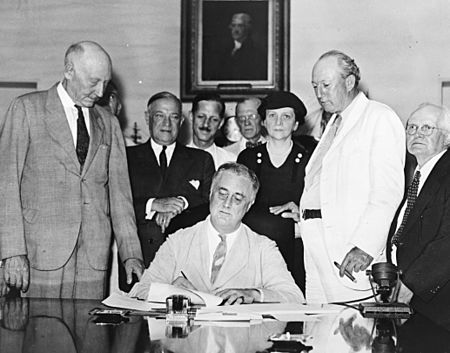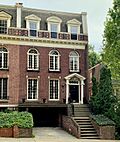Frances Perkins facts for kids
Quick facts for kids
Frances Perkins
|
|
|---|---|
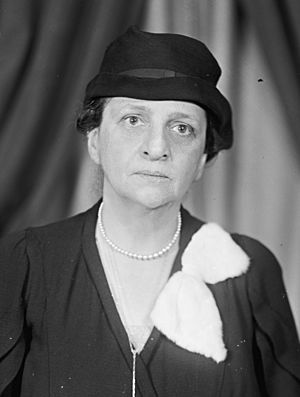 |
|
| 4th United States Secretary of Labor | |
| In office March 4, 1933 – June 30, 1945 |
|
| President | Franklin D. Roosevelt Harry S. Truman |
| Preceded by | William N. Doak |
| Succeeded by | Lewis B. Schwellenbach |
| Member of the United States Civil Service Commission | |
| In office 1945–1953 |
|
| President | Harry S. Truman |
| Succeeded by | Frederick Lawton |
| Personal details | |
| Born |
Fannie Coralie Perkins
April 10, 1880 Boston, Massachusetts, U.S. |
| Died | May 14, 1965 (aged 85) New York City, New York, U.S. |
| Political party | Democratic |
| Spouse | Paul Wilson |
| Children | 1 |
| Education | Mount Holyoke College (BS) Columbia University (MA) University of Pennsylvania |
|
Work institutions
|
Cornell University
Telluride Association |
Frances Perkins (born Fannie Coralie Perkins; April 10, 1880 – May 14, 1965) was an American champion for workers' rights. She served as the 4th United States Secretary of Labor from 1933 to 1945. This was the longest time anyone held that job.
As a member of the Democratic Party, Perkins made history. She was the first woman ever to be part of a presidential cabinet. She was a strong supporter of President Franklin D. Roosevelt. She helped make workers' issues a key part of the New Deal plan.
Perkins played a huge role in creating Social Security in 1935. This program helps people with money when they retire or can't work. She also helped the government work with labor unions. Her department helped solve worker strikes. During World War II, she dealt with many labor questions. This was when skilled workers were very important, and women took on jobs usually done by men.
Contents
Early Life and Education
Frances Perkins was born in Boston, Massachusetts. Her parents were Susan Ella Perkins and Frederick William Perkins. She spent much of her childhood in Worcester, Massachusetts.
Perkins went to Classical High School in Worcester. In 1902, she earned a bachelor's degree in chemistry and physics from Mount Holyoke College. While there, she became interested in social issues and the women's right to vote. One of her teachers, Annah May Soule, had students visit factories. This helped Perkins see how important it was to improve working conditions.
Early Career and Social Work
After college, Perkins taught chemistry for a few years. She also volunteered at settlement houses in Chicago. These places helped poor people and immigrants. She worked with Jane Addams at Hull House. In 1905, she changed her first name from Fannie to Frances.
In 1907, she moved to Philadelphia. She studied economics at the University of Pennsylvania and worked as a social worker. Later, she moved to New York City. She joined the movement for women's voting rights. She earned a master's degree in economics and sociology from Columbia University in 1910.
Fighting for Workers' Rights
In 1910, Perkins became well known in New York. She led the New York office of the National Consumers League. She worked hard to get better working hours and conditions for people. She also taught sociology at Adelphi College.
A year later, she saw the terrible Triangle Shirtwaist Factory fire. This event changed her life. Many young women worked at the factory, but it had no fire escapes. When the building caught fire, 146 workers died. Perkins felt that weak laws were to blame for this loss of life.
Because of the fire, Perkins joined the Committee on Safety of the City of New York. This group worked to make factories safer. She helped New York pass a law in 1913. This law limited how many hours women and children could work to 54 hours a week. She worked with Franklin D. Roosevelt to get this important law passed.
Family Life
In 1913, Perkins married Paul Caldwell Wilson, an economist. She kept her maiden name, Frances Perkins. She did not want her work to affect her husband's career. They had a daughter named Susanna in 1916. After Susanna was born, Paul Wilson faced health challenges. Perkins returned to her public work to support her family.
Work in New York State Government
Before moving to Washington, D.C., Perkins held important jobs in New York state government. In 1919, Governor Al Smith appointed her to the Industrial Commission of New York. This made her one of the first female commissioners in New York. She helped oversee industrial safety and worker conditions.
In 1929, Franklin Roosevelt became the new governor of New York. He appointed Perkins as the state's industrial commissioner. She managed an agency with 1,800 employees. Perkins helped New York become a leader in progressive reforms. She pushed for more factory inspections. She also helped reduce the workweek for women to 48 hours. She fought for minimum wage and unemployment insurance laws. She worked hard to end child labor and keep women workers safe.
Cabinet Career
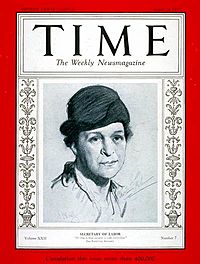
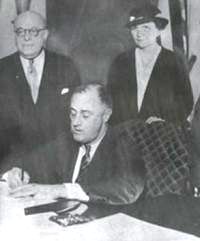
In 1933, President Roosevelt asked Perkins to join his cabinet. Perkins told Roosevelt a long list of things she wanted to achieve for workers. This included Social Security and a minimum wage. Roosevelt agreed to support her. He nominated her as Secretary of Labor.
As Secretary, Perkins led the Department of Labor. She held this job for 12 years, longer than anyone else. She was the first woman to hold a cabinet position in the U.S. This also meant she was the first woman in the presidential line of succession. President Roosevelt strongly supported her goals.
Perkins played a key role in Roosevelt's New Deal programs. She helped write important laws. Her biggest contribution was helping to create the Social Security Act of 1935. This law created a system of benefits for retired workers and others.
She also created the Immigration and Naturalization Service. She wanted fair immigration policies. In 1938, she spoke at the International Labour Organization in Geneva. She asked the group to help the world economy recover.
Perkins faced some challenges. In 1939, some members of Congress wanted her to deport Harry Bridges. He was a union leader accused of being a communist. But the Supreme Court later said Bridges was innocent.
Perkins's time as Secretary ended on June 30, 1945. This was after President Roosevelt passed away. Harry Truman became president and chose a new Secretary of Labor.
Later Life and Legacy
After being Secretary of Labor, President Truman asked Perkins to join the United States Civil Service Commission in 1945. She worked there until 1952, when her husband passed away. During this time, she wrote a book about her experiences with President Roosevelt. It was called The Roosevelt I Knew.
Perkins continued to be active after leaving government. She taught and lectured at Cornell University until her death in 1965. She was 85 years old. She also gave guest lectures at other universities. She lived at the Telluride House at Cornell, a special intellectual community. Many say this was a very happy time in her life.
Perkins is buried in the Glidden Cemetery in Newcastle, Maine.
Her Impact and Character
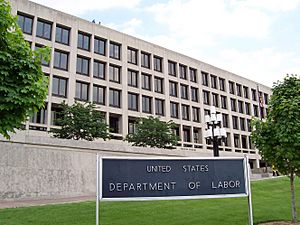
Frances Perkins is famous for being the first woman in a presidential cabinet. She also achieved many important things. She helped create social safety net programs. These include Social Security, unemployment insurance, the federal minimum wage, and laws against child labor.
As the first woman in such a high position, Perkins faced a big challenge. She had to be very capable and smart. This would help make it easier for other women to get important jobs after her.
Perkins was known for being calm and reserved. But she was also very passionate about workers' rights. Once, during a difficult auto workers' strike, she strongly criticized the head of General Motors for not meeting union demands.
Her achievements show her deep care for workers and people in need. She was excellent at making big changes to laws.
Memorials and Honors
In 1980, President Jimmy Carter renamed the headquarters of the U.S. Department of Labor. It is now called the Frances Perkins Building in Washington, D.C. She was also honored with a postage stamp that same year. Her home in Washington, D.C., and her family home in Maine are both National Historic Landmarks.
The Frances Perkins Center in Maine teaches people about her work. It also helps preserve her family home. Mount Holyoke College has a special program named after her. The Frances Perkins Program helps older women go back to college to earn a degree.
In 1982, Perkins was added to the National Women's Hall of Fame. In 2022, the Episcopal Church liturgical calendar added Frances Perkins. She is honored with a special day on May 13.
Maine Department of Labor Mural
A mural showing Perkins was displayed in the Maine Department of Labor headquarters. In 2011, Maine's governor ordered the mural removed. He said he received complaints. Later, a lawsuit was filed to protect the mural. As of 2013, the mural is in the Maine State Museum.
See also
 In Spanish: Frances Perkins para niños
In Spanish: Frances Perkins para niños
- List of female United States Cabinet members
- Silicosis


